Harriet Jacobs Dedicated Her Life to Uplifting Newly Freed African Americans Post Civil War

From the Office of Historic Alexandria
Alexandria, VA – A Note from OHA: In recognition of Black History Month, the Office of Historic Alexandria highlights the contributions of one of the significant figures in American history and her relationship to Alexandria. To learn more about Black History Month and Historic Alexandria, please visit alexandriava.gov/museums/black-history-month-in-alexandria.
Along with Harriett Beecher Stowe’s Uncle Tom’s Cabin, perhaps no book had as powerful an impact in the cause of abolitionism as Harriet Jacobs’ Incidents in the Life of a Slave Girl. Unlike Stowe’s fictionalized narrative, Jacobs, writing under the pseudonym of Linda Brent, related her real-life experience of resisting the sexual advances of her master, Dr. James Norcum, from the time she was 15.
Her ordeal to escape him, which included hiding in a crawlspace for seven years before she finally escaped to the North, framed slavery as the opposite of the middle-class morality that many of Jacobs’ readers claimed for themselves. Having found herself in the company of other prominent abolitionists in Rochester, NY, including Frederick Douglass, Jacobs was able to evade attempts by Norcom and later his daughter to recapture her by escaping to Massachusetts and England.

It was a slight by Harriett Beecher Stowe toward her daughter that convinced Jacobs to write her own story, finally published in 1861, right before the start of the Civil War and 19 years after she escaped from North Carolina.
In the spring of 1862, Harriet Jacobs came to Alexandria. She sought to use her fame to build a relief network to care for the newly freed enslaved people who flocked to occupied Alexandria. These newly freed people utilized the Union Army’s policy of not returning “contrabands” to their Confederate masters to stay free. Jacobs became one of the most credible scribes of the conditions that these new arrivals met when they crossed into Alexandria.
In a memoir titled Life Among the Contrabands, Jacobs introduced their plight to the readers of William Lloyd Garrison’s The Liberator in September 1862. Still using the pseudonym of Linda, she wrote:
“I found men, women, and children all huddled together, without any distinction or regard to age or sex. Some of them were in the most pitiable condition. Many were sick with measles, diphtheria, scarlet and typhoid fever. Some had a few filthy rags to lie on; others had nothing but the bare floor for a couch.”
What struck Jacobs about the newly freed men and women was their desire to educate themselves and their children. In a section of Life Among the Contrabands, Jacobs wrote:
“A word about the schools. It is pleasant to see that eager group of old and young, striving to learn their A, B, C, and Scripture sentences. Their great desire is to learn to read. While in the school-room, I could not but feel how much these young women and children needed female teachers who could do something more than teach them their A, B, C. They need to be taught the right habits of living and the true principles of life.”
Jacobs went north to raise money to start a free school for those who settled in a neighborhood known as Petersburg. Upon her return, she discovered that locals had raised $500 and built a “roughly finished house for their school and meetings.” On January 11, 1864, The Jacobs Free School opened at this location with 75 students. Jacobs, her daughter Louisa Matilda, and several White Northerners taught up to 225 students with ongoing support from the New England Freedmen’s Aid Society.
In April 1864, Harriet and Louisa published a letter in the National Anti-Slavery Standard detailing a conflict between the White and African American teachers over who would lead the school. The two factions agreed to put the decision to the students themselves, who chose to have the African American teachers in charge of the school.

Harriet and Louisa Matilda stayed in Alexandria until the Union victory in 1865. They then moved to Savannah, Georgia, hoping to replicate their success in Alexandria. After the assassination of Abraham Lincoln and the subsequent disbanding of the Freedmen’s Bureau by his successor, Andrew Johnson, Jacobs and her daughter’s project came under threat.
Mother and daughter left Savannah in 1867, and Harriet returned to England hoping to raise more money for her relief work. The violence against African Americans in the South following the disbandment of the Freedmen’s Bureau convinced her to abandon the Savannah project, and she returned to private life in Cambridge, MA. In 1877, Harriet and Louisa Matilda moved to Washington, DC, where Harriet died in 1897.
ICYMI: Community Engagement Events Planned Around Potomac Yard Arena Development




